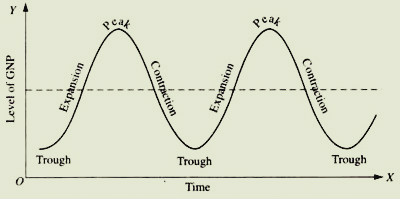What is a business cycle?
Simply put, a business cycle refers to the fluctuations in economic activity. Little did you know how important the monthly employment report issued by the Bureau of labor statistic is to investors and portfolio managers. The two most important variables used to determine which phase an economy is in, in the business cycle is the Real GDP (Gross Domestic Product) of the economy and the rate of employment. So you see why the information on employment provided by the bureau of labor statistics is very important.
I am sure you would be asking now “What are the phases in a business cycle?” Well that is the purpose of this post. I am writing to highlight the different phases in a business cycle and the characteristics of each phase. There are four phases in a business cycle, they are the expansion phase, characterized by an increasing real GDP; Peak phase, were GDP stops increasing and begins decreasing; contraction or recession phase, were real GDP is decreasing; and the trough phase were real GDP stops decreasing and starts increasing.
Now, let us go into further details:

Business Cycle
- Expansion: Being in the expansion phase means that the economy is stable and growing, and this growth is fueled by an increase in consumer spending’s, increase in employment and increased investments. As an expansion reaches its peak, increase in employment, consumer spending’s and investments slow but still remain positive; although inflation by this time would have increased and would be accelerating.
- Peak: As the name implies, this represents the peak of activities in an economy. The economy is producing at maximum capacity, and as a result cannot increase employment. At this stage, inflation is quite palpable and inflationary pressures drive prices upwards.
- Contraction or recession: After a peak period, reality sets in, inflation is high, so also is unemployment; and real GDP is decreasing. The economy instinctively slips into a correction stage, fueled by a contraction or recession, which brings about a decline in most sectors. The positive thing the contraction or recession contributes is a typical decrease in inflation. One of the negative contributions though is the laying off of workers due to the harsh economic conditions. By so doing, this drives the unemployment rate upwards, while real GDP still falls.
- Trough: At the end of the contraction phase, the economy reaches a trough which is characterized by new expansion or recovery, positive economic growth and drastic reduction of inflation and inflationary pressures. Note that in this phase, employment growth may not have started increasing because employers would want to be certain that the economy is truly recovering and is out of a recession.
It is noteworthy to know that the employment rate and real GDP are not the only variables used in identifying turning points in the business cycle. According to the National Bureau of Economic Research in the United States, a wider variety of economic data such as employment, industrial production and real personal income are used in identifying turning points in the business cycle.
Recommended Readings
Lars Tvede., Business Cycles: History, Theory and Investment Reality 3rd Edition






Leave a Reply